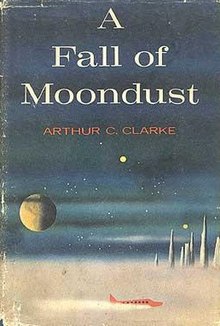A Fall of Moondust

Cover of the first edition
|
|
| Author | Arthur C. Clarke |
|---|---|
| Country | United Kingdom |
| Language | English |
| Genre | Science fiction |
| Publisher | Gollancz |
|
Publication date
|
1961 |
| Media type | Print (Hardback) |
| Pages | 224 pp |
| ISBN | (reprint) |
| OCLC | 59497789 |
A Fall of Moondust is a hard science fiction novel by Arthur C. Clarke, first published in 1961. It was nominated for a Hugo Award for Best Novel, and was the first science fiction novel selected to become a Reader's Digest Condensed Book.
By the 21st century, the Moon has been colonized, and although still very much a research establishment, it is visited by tourists who can afford the trip. One of its attractions is a cruise across one of the lunar seas, named the Sea of Thirst, (located within the Sinus Roris) filled with an extremely fine dust, a fine powder far drier than the contents of a terrestrial desert and which almost flows like water, instead of the common regolith which covers most of the lunar surface. A specially designed "boat" named the Selene skims over the surface of the dust in the same manner as a jetski.
But on one cruise, a moonquake causes an underground cavern to collapse, upsetting the equilibrium. As the Dust-cruiser Selene passes over, it sinks about 15 metres below the surface of the dust, hiding the vessel from view, and trapping it beneath the dust. Immediately there are potentially fatal problems for the crew and passengers inside. The sunken Selene has a limited air supply, there is no way for heat generated to escape, communications are impossible, and no one else is sure where Selene has been lost. As precious time begins to run out and the Selene heats up and the air becomes unbreathable, young Captain Pat Harris and his chief stewardess Sue Wilkins try to keep the passengers occupied and psychologically stable while waiting to be rescued. They are helped by a retired space ship captain and explorer, Commodore Hansteen, who is initially traveling incognito.
Chief Engineer (Earthside) Robert Lawrence is skeptical that a rescue can be mounted, even if the Selene can be located. He is ready to abandon an initially unsuccessful search, when he is contacted by Thomas Lawson, a brilliant but eccentric astronomer who, from his vantage point on a satellite high above the Moon, Lagrange II, believes he has detected the remains of a heat trail on the surface. An expedition is organized and Lawrence indeed makes contact with the Selene. However the completely alien environment results in numerous unforeseen complications. The rescue mission decides to sink a tube supplying oxygen to the Selene first, in an effort to buy time to think of a way to get the passengers out. However, this becomes a race against the clock, as the heat in the Selene knocks out the chemical air purification system and the passengers are suffering from CO2 poisoning. To preserve air, most passengers enter a chemically induced sleep, with only Pat Harris and physicist Duncan McKenzie staying awake. Just in time, the rescuers manage to drill a hole in the roof and deliver an air supply.
...
Wikipedia
